
Imagine trying to catch a fast-moving ball — your eyes dart ahead before your hands even move. That’s oculomotor control in action: the brain’s built-in guidance system that directs where your eyes go so your body can respond. It’s what lets you read a line of text smoothly, track a bird in the sky, or quickly glance between a traffic light and the car in front of you without losing awareness. We often don’t notice it, but this eye-movement coordination is one of the silent superpowers of our everyday life.
Researchers like David A. Robinson at Johns Hopkins University have studied oculomotor control for decades, showing how tiny muscles around the eyes work with brain signals to create precise and lightning-fast movements. One key finding is that these movements aren’t just reactive — your brain often predicts where to look next before something even happens, a process called “anticipatory eye movement.”
The research also reveals that oculomotor control is deeply linked to attention and focus. When your eyes can move and lock onto what matters quickly, your brain processes information faster. This is why athletes, pilots, and even gamers often train their eye-tracking skills to improve performance. And when the system falters — due to fatigue, injury, or neurological conditions — tasks like reading, driving, or playing sports can suddenly feel much harder.
In short, oculomotor control is like the GPS for your eyes. It works quietly in the background, keeping your gaze — and by extension, your actions — on target. Without it, even the simplest everyday activities would feel clumsy and disconnected.
RELATED POSTS
View all


